How much difference does three feet – and 50 years – make?
It’s the difference between a 1970 VW Beetle – that could carry four people, two of them extremely uncomfortably and all of them very slowly – and a 2021 VW Atlas. Which can carry seven comfortably and speedily.
The Atlas is without doubt the largest VW ever. You could probably fit the smallest VW, ever, inside of one.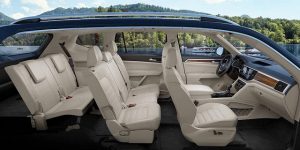
But it isn’t overwhelmingly large, even relative to the very small.
What It Is
The Atlas is a full-size, three-row/seven-passenger crossover SUV that competes with models like the Subaru Ascent, Mazda CX-9 (which seats seven), Honda Pilot (which takes eight) and also the new Kia Telluride/Hyundai Palisade, which also seat eight.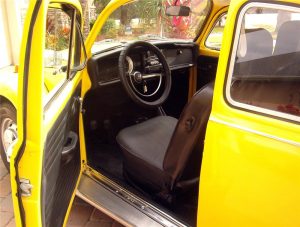
Prices start at $31,545 for the base S trim, which comes standard with a turbocharged 2.0 liter four cylinder engine, an eight-speed automatic transmission and front-wheel-drive.
VW’s 4Motion all-wheel-drive is available optionally.
You can also opt for a V6 – which was rare in the class (the Ascent and CX-9 don’t even offer one) . . . until the Telluride/Palisade appeared last year. Those two come standard with one.
Prices for a V6-equipped Atlas start at $34,745 for an S trim with FWD and crest at $50,691 for an SEL Premium R-Line trim with fully automated self-parking, a 12-speaker Fender audio rig, 21-inch wheels, a Digital Cockpit instrument cluster and almost everything you’d get if you bought an Audi-badged crossover . . . without the Audi price tag.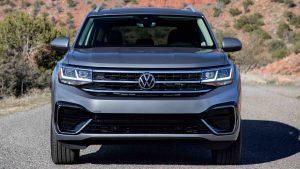
What’s New
The Atlas gets a restyled front end and revised interior trim.
What’s Good
Available V6 (unavailable in four-cylinder-only rivals like the Ascent and CX-9)
Pulls as much as 5,000 lbs.
Related to a German luxury car brand.
What’s Not So Good
Newer rivals like the Telluride/Palisade seat eight – come standard with a V6 – and cost less.
Only tows 2,000 lbs. if you don’t opt for the V6.
AWD isn’t standard (it is in the Ascent).
The Atlas is the largest VW so far, but it comes standard with an engine only slightly larger than a ’70 Beetle’s engine. Both are four cylinder engines – the ’70 displacing 1.6 liters and the ’21 displacing 2.0 liters. Which isn’t much of a difference.
But there’s 50 years’ difference between then and now when it comes to how much power you get, one vs. the other.
Back in ’70, 1.6 liters meant 56 air-cooled horsepower and 82 ft-lbs. of torque at 3,000 RPM. Today, 2.0 liters means 235 horsepower and 258 ft.-lbs. of torque.
It also means an eight-speed automatic today vs. a four-speed manual then.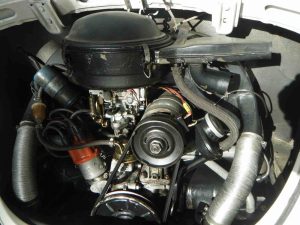
Plus, heat.
And it means 0-60 in just over 7 seconds vs. 17 seconds 50 years ago.
You can send all that water-cooled and turbocharged horsepower – and torque – through the front wheels or all four wheels as opposed to just the rear wheels, back in 1970.
To be fair to the old Beetle, it was pretty good in the snow even so . . . if you could see where you were going through the fogged-up windshield.
The optional Atlas engine is VW’s 3.6 liter V6, which you couldn’t get in a Beetle. It doesn’t need a turbo to make 276 horsepower and 266 ft.-lbs. of torque, either.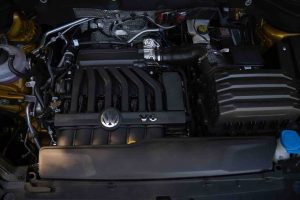
It’s also paired with the eight-speed automatic and your pick of FWD or AWD.
Noteworthy: Neither Atlas engine requires premium gas to make the advertised power or deliver the advertised mileage. Some rivals’ engines do require it (that’s you, Mazda CX-9).
As mentioned earlier, the base Atlas with the four cylinder engine can only pull 2,000 pounds – about the same as most mid-sized cars and less than some of them. But you can more than double the VW’s max tow rating – to 5,000 lbs.
If you buy the V6.
Size does matter – when you’re trying to park, for instance.
The Atlas wont fit into a Beetle-sized spot, but it will fit into most spots because it’s only about six inches longer overall than a current mid-sized sedan like the Toyota Camry – which doesn’t seat seven.
You also sit higher, in part because the Atlas is a crossover – but also because of the super-tall 20-inch throwing star wheels – five inches taller than a ’70 Beetle’s wheels . This helps you see better where you’re parking. And this VW can park itself – totally hands-free – if you buy the Premium trim, which comes standard with this technologically amazing . . . technology.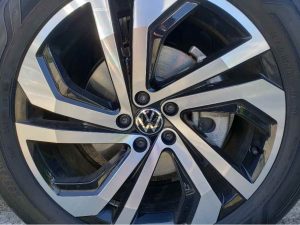
You also sit wider – literally and visually. There’s 15.9 inches more of Atlas between the door panels than there was of Beetle back in 1970, which you can feel and see as you look out over a broad, flat slab of hood that looks like you could play ping-pong across it.
But, it’s not overwhelmingly large-feeling. In fact, it’s easier to drive – and arguably, to park – than a ’70 Beetle, which didn’t have power steering and only just barely enough power to reach the speed limit on the highway, without much left in reserve.
Speaking of power . . .
Whether to buy the four or the six is less a question of power – or performance – because both engines are very close in both departments – but rather whether you prefer better gas mileage at the possible cost of turbo-related troubles at some point down the road.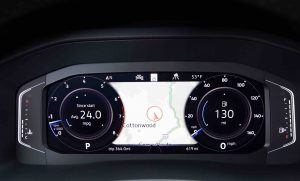
The V6 is definitely thirstier – 16 city/22 highway vs. 21 city/24 highway for the turbo’d four – but it has no turbo, so there’s no chance you’ll ever have to replace the turbo. Or the intercooler. Or the other parts that come with a turbocharged engine.
With the four, you might. The truth is, we don’t yet know – because not enough time has elapsed yet to really gauge the long-term durability of modern turbocharged small engines. What we do know from the historic record is that the turbo’d engines of the past tended to need repairs sooner than non-turbo’d ones. Whether because of not-as-sound engineering or too much boost for the long haul. We’ll know about the current crop in about ten years from now.
Either way, the Atlas is almost startlingly maneuverable, especially as regards steering – which is very light and very precise. Hardly any input is necessary to course-correct and even better, the Atlas doesn’t try to correct course for you.
Which brings up another thing to know about the Atlas: It lets you drive.
It does come with “advanced driver assistance technology” – the automotive equivalent of the Face Diaper in that both are pro forma expressions of piety toward current imbecile orthodoxies – but they aren’t intrusive and can be easily turned off. One amusing feature is the speed limit nanny, which displays an exclamation-pointed message in the dash that you have exceeded whatever the posted speed limit is – which the car knows because of GPS mapping and real-time monitoring of your progress (and speed in relation to the road you’re on).
In Europe, this stuff is preparatory to speed limiting – in real-time. The car will slow down if you don’t. For now, this technology is functionally impotent – in the U.S. But the worrisome thing is it’s there – and could probably be turned on anytime.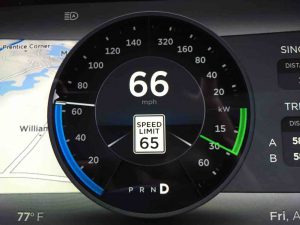
The Atlas is also less distracting to drive because you can adjust the climate control without looking at an LCD touchscreen. Even the top-of-the-line trims have rotary knob controls for these functions, enabling you to make them function without taking your eyes off the road.
There is also 8 inches of clearance, if you need to go off-road, though like all the vehicles in this class, the Atlas is designed for on-road duty. Still, it can go in the grass if you need to – and it can handle snow on the road much better than any car – without making you drive a vehicle that doesn’t drive like one.
VW – a small car company – faced the same problem that Porsche had when it created the first big Porsche. How to make a big vehicle not too big – both in size and looks – while still being big enough to meet the needs of people who need more than a small car?
The result is a car that looks hunky but that’s just three feet longer than a Beetle – one of the smallest cars ever made. Yet there’s more room in its third row than a Beetle had in its second – and with a second row that’s light-years roomier than the front row of a ’70 Beetle.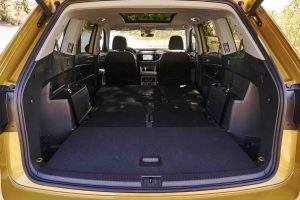
You could almost put a Beetle inside the Atlas, too. It has 20.6 cubic feet of space behind its third row and 96.8 cubic feet with its second and third row folded. That’s significantly more cargo room than even the previously class-leading Honda Pilot can boast of (82.1 cubic feet) and it edges out the new Telluride, too (87 cubic feet).
Shoulder room – in both rows – is among the best in the class at 61.5 inches and 60.8 inches respectively. The Honda Pilot has a little more wiggle room in this category – 62.2 inches up front and 62 in the second row – but it cannot cart around as much stuff as the broad-shouldered Atlas can.
You can get also get unimaginable – back in 1970 – features in this VW, such as a flat-screen digital instrument cluster.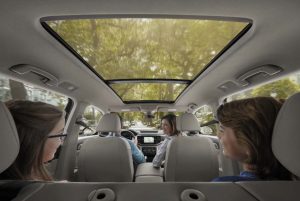
Plus a working heater.
Also an almost entirely glass roof – if you want one. But, you’ll have to step up to the SE trim to order one. If you do, you can also sub out the bench seats for captain’s chairs. If you order the SEL trim, the panorama roof comes standard, along with the Digital Cockpit instrument cluster (in lieu of needle/analog gauges) and you also get a heated steering wheel.
The other thing you get is kinship to Audi.
Not shared-platform kinship but engineering and general kinship. VWs are made by the same company that makes Audis. So even though the Atlas is not a rebadged Audi Q7 even though they look very similar – they are built on different platforms, MQB for the VW and MLB for the Audi – they feel similar because they issue from the same loins, so to speak.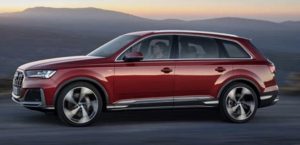
But the VW is the roomier – as well as the more practical – and a great deal less pricey than its kissing cousin of the overlapping ovals. The Q7 starts at $54,800 – about $4k less than a top-of-the-line Atlas with everything . . . including – once again – much more cargo room (96.8 cubic feet with the seats down vs. just 69.9 in the Audi).
The Rest
In addition to its ample shoulder and cargo room, the Atlas has a very roomy center console storage bin that can take a laptop plus a handful of other things. Plus side pockets.
The twin USB ports up front are in sight and in reach, just ahead of the shifter – and VW has gotten rid of their VW-specific dongle-thing (adapter) you had to use in some earlier models to plug in a device.
The Atlas also offers a 12V power point and you can get a 115V household-style outlet, too.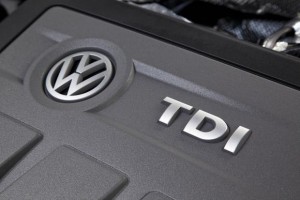
The tragedy is that the Atlas does not offer a diesel engine – which VW could have and very likely would have offered, had it not been for Uncle and his vicious persecution of VW over a pedantic hairs-breadth of difference between allowable and not allowable NOx emissions.
Whatever your thoughts about this “cheating,” the fact is a TDI-powered Atlas would likely have been capable of 35-plus MPG – and that would have meant a lot more than a hair’s breadth of fuel savings – as well as a lot less of other emissions (including the now off-the-radar carbon dioxide) simply by dint of burning so much less fuel per mile.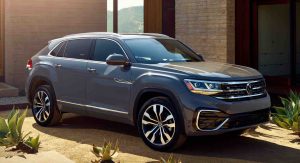
It also would have put some distance between the Atlas and newcomers like the eight-passenger Kia Telluride and its twin, the Hyundai Palisade – both of which comes standard with powerful – but thirsty – gas V6s.
Finally, if you only need five seats, you might have a look at the smaller Atlas – the Cross Sport. It comes with two rows – and the V6 standard. If we’re lucky, we may also soon see a pick-up based on the Atlas, similar in concept to the Honda Ridgeline.
Stay tuned!
The Bottom Line
If you’re looking for something with the room but not the size, an Atlas might fit!
. . .
Got a question about cars, Libertarian politics – or anything else? Click on the “ask Eric” link and send ’em in!
If you like what you’ve found here please consider supporting EPautos.
We depend on you to keep the wheels turning!
Our donate button is here.
If you prefer not to use PayPal, our mailing address is:
EPautos
721 Hummingbird Lane SE
Copper Hill, VA 24079
PS: Get an EPautos magnet or sticker or coaster in return for a $20 or more one-time donation or a $10 or more monthly recurring donation. (Please be sure to tell us you want a magnet or sticker or coaster – and also, provide an address, so we know where to mail the thing!)
If you’d like an ear tag – custom made! – just ask and it will be delivered.
My latest eBook is also available for your favorite price – free! Click here. If that fails, email me at EPeters952@yahoo.com and I will send you a copy directly!


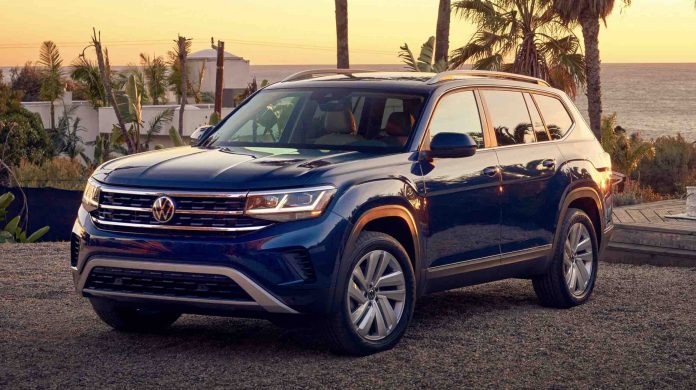


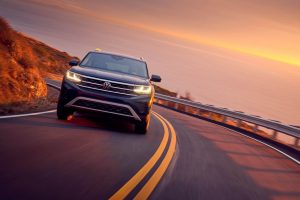
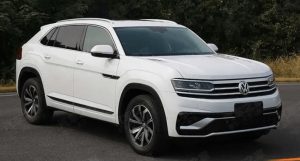








That same 2.0T engine making 258 TQ is found in my 2016 GTI (read your review on it too). I wonder if those simple software flashes available also apply to the Atlas.. where in mere minutes you could add +100 TQ to boost to 350TQ-ish range..!! That’d be Wiiiiiild with the AWD option!!!
Hi Anon,
I bet they do apply; I bet the system is largely the same. Still, and without in any way disparaging the 2.0 engine – which is an excellent engine – I think it’s very sad VW cannot offer a TDI in the Atlas. Such an engine is ideally suited to a large crossover SUV and would not only give it the torque needed to easily pull a 5,000-plus pound trailer, it’d be capable of 35 MPG or more on the highway even in this big galoot!
I rented one of these once. It was *too big*. Visibility was poor, esp out the back window and the blind spots were huge.
Nice car, but I get cognitive dissonance seeing a VW badge on something that huge. I’ll take a Karmann Ghia or square back any day thanks. Hundreds of thousands of miles of dirt cheap easy maintenance motoring, in my book, more than makes up for luxuries. It also helped that MSRP on a square back in the late sixties was under three grand
Hi Ernie,
I have always wanted to own a Karmann Ghia; I have owned practically ever other type of classic VW, including a Thing and a Squareback (one of the first PFI cars sold in the U.S.)
I can see why people buy this VW, though. If I had two kids, it’d be practically a necessity.
I think of it as a modern Bus. If VW’s didn’t have questionable reliability, I would consider one. Surprised it has a V6